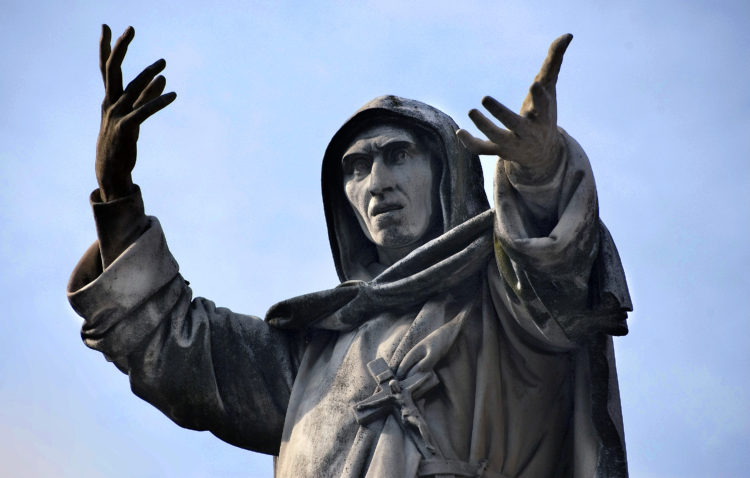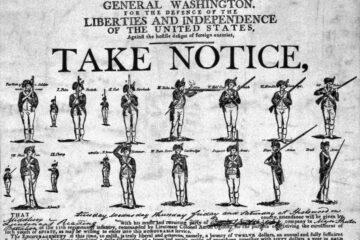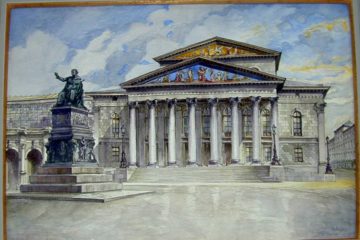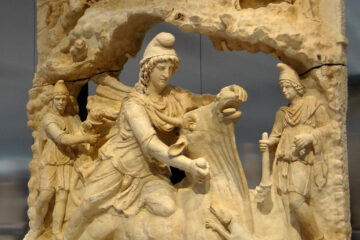Evangelical Democracy

The incredible, frightening, yet at turns hilarious story of the fanatical Christian “holy man” Savonarola and his brief rule over 15th century Florence — told as only Revilo Oliver can tell it.
by Revilo P. Oliver
WALKING WITH BARE FEET over burning coals is currently a popular and lucrative device for extracting money from suckers who can be impressed by a display of seemingly miraculous and supernatural powers. If you have an inclination to make yokels gawk, you will find full instructions for the trick in a pair of articles in the issue of the Skeptical Inquirer for Fall 1985. The vogue of firewalking today as a proof of “paranormal” and presumably psychic powers reminded me of one of history’s many ironies.
In the Fifteenth Century, Florence was one of the cultural capitals of the Renaissance, made illustrious by its artists, who are now known as Old Masters, and by its Humanists, one of whom was so eminent that his name was naturalized in English as Politian. The Golden Age of Florence ended in a way I summarized years ago in an article on Politian: “On 8 April 1492, Lorenzo il Magnifico died, presumably of natural causes. The next day, the body of his physician, a noted professor of medicine, was found at the bottom of a well. With such auspices the power of the Medici, a beneficent despotism covered by a now threadbare and tattered mantle of republican forms, passed into the tremulous hands of Politian’s former pupil, Piero, a boy of twenty who was heir to responsibilities beyond his capacities and to accumulated hatreds that might have daunted a Caesar.”
Piero lasted for only two years. He was driven out of Florence by a revolution incited by the famous Savonarola, an evangelical Dominican of the “moral majority” type, who preached Hell Fire and Damnation so eloquently that he scared two-thirds of the population of Florence out of their wits. He is now venerated by most Protestants, who esteem him as a precursor of Luther and the Reformation, but it is well to recall the judicious characterization of him by the eminent historian, William Roscoe, in the first volume of his Life and Pontificate of Leo the Tenth: “Savonarola united in himself those exact proportions of knavery, talents, folly, and learning, which, combined with the insanity of superstition, comprise the character of a fanatic.”
The holy demagogue communicated his fanaticism to his followers, who were or professed to be of the “born again” type so sadly common in our time, inflated with their own righteousness as a substitute for intelligence, and so numerous that they, together with the citizens whom they harassed into acquiescence, formed a politically potent majority in elections. They hated, with moralistic venom, the distinguished men who had been Lorenzo’s friends, and, as so commonly happens, the Servants of the Lord felt that their plethora of righteousness exempted them from “pagan” morality while doing the Lord’s work. In my article I showed, on the basis of the then unpublished chronicle by a neutral contemporary, Piero Parenti, that it was highly probable that the man who poisoned Giovanni Pico, Count della Mirandola, was an agent of Savonarola’s faction, and that it was quite possible that the same faction also poisoned Politian, who died “mysteriously” at almost the same time.
From 1494 to 1498, Savonarola was the real ruler of Florence, for although he held no office himself and pretended to be only the godly prior of the local Dominican establishment, no one whom he had not selected could be elected to any office under the constitution that he had himself drafted for the “restored” Florentine Republic. It must be admitted that the friar’s nominees showed exemplary courage and resolution in dealing with Charles VIII of France and his army, and that their civil government was, on the whole, honest, just, and efficient.
In ordering the civil affairs of Florence, Savonarola was a practical and prudent man, but the “insanity of superstition” to which Roscoe refers, coupled with the intoxication that comes upon men who find they can sway crowds with oratory, made him believe that Jesus had appointed him to stamp out “worldliness,” “paganism,” and sin in Florence. He attempted a Puritanic reformation of Florentine society. His devout followers, who were called ‘Snivellers’ (Piagnoni) by men who remained rational or retained the normal human preference for pleasure over austerity, were not a majority at any time, but they had the Christian zeal for chivying everyone less righteous than they, and they imposed on an effective majority of the population. The usual Christian repudiation of intelligence was most conspicuous in bands of febrile youngsters who boasted in their songs that they were inspired by “Christ’s holy madness” as they swarmed through Florence, looking for sins to denounce. Savonarola’s rule attained its memorable culmination in the Carnival season in which the gaiety and often licentious merriment that normally preceded the gloomy austerities of Lent was replaced by an orgy of piety and the famous “Bonfire of Vanities.” Crazed Florentines piled up the books of “lascivious” poets, paintings that were “pagan,” and other works of art that were deemed irreligious, while foolish women contributed the dresses and cosmetics they had used while engaged in the mortal sin of appearing attractive to men. A Jew, who was doubtless watching with amusement the frenzied tribute to a god his race had imposed on Aryans, offered twenty thousand florins for a heap of feminine fineries that were to be consumed by the flames, but he could not shake the piety of their infatuated owners.
Savonarola’s apologists claim that nothing of great value was destroyed in the holocaust — that there were other copies of all the books and manuscripts that were burned (I am not so sure), and that the paintings had little artistic merit. One cannot, of course, determine the aesthetic value of paintings that can no longer be seen or even identified. We regret that Fra Bartolomeo, whose extant religious paintings attest his talent, contracted the epidemic delirium and himself cast into the flames all of his canvasses that depicted nude beauty or other sinful incitements to ungodliness. But we have no inventory of what else perished in the huge bonfire, and conjectures about their cultural value will naturally depend on the prejudices of the writer.
I mention the “Bonfire of Vanities” to show how complete was Savonarola’s temporary dictatorship over Florence. Like many others, however, he forgot that power attained by exciting irrational enthusiasms in crowds is precarious.
It was one thing to reform Florence, where his mobs of ‘Snivellers’ would enforce his every command, but quite another thing to reform Rome, where he had no adherents and his oratory could not be heard. Savonarola, inflated with moral indignation, began to denounce the notorious Pope Alexander VI, who, like high-minded politicians today, felt outraged by vilely irresponsible accusations that he could be so base as to do what he was actually doing. The Pope, finding he could neither conciliate nor bribe the impassioned dervish, eventually excommunicated Savonarola and laid Florence under an interdict. Savonarola replied with eloquent fulminations that were futile outside Florence. He did not actually call the Pope an Antichrist, as some of his Protestant admirers like to claim, but he did pronounce Alexander unfit for the office to which God had presumably elevated him, and he called urgently for a Council of the Church to rectify God’s blunder.
Many Florentines were understandably confused by the manifest contradictions between what God told Savonarola in the visions that were vouchsafed him with ever increasing frequency and what God’s duly anointed vicar on earth identified as God’s will. Although quite a few priests, reflecting that Savonarola was in town and Alexander in Rome, continued to perform the magic rites of the Church, as it was inconvenient to have weddings, funerals, and other sacraments available only on a bootleg basis. What was more important, Florentine merchants, who, by one consequence of the interdict, were denied legal protection outside Florence, became convinced that while it is nice to lay up treasures in Heaven, it is more urgent to lay up treasures on earth. They joined the bankers, who had never been reconciled to a regime that denied them the joys of usury, in a covert but powerful resistance to unprofitable godliness, and some of Savonarola’s political appointees secretly became his vigilant enemies.
Persons who know little of history like to believe what they are told by Catholic propagandists, that Europe before the lamentable Reformation was united by the Faith, and the Church was one unanimous army of holy men under the benign command of St. Peter’s divinely recognized heir. In all organized religions, however, the proverbial odium theologorum is the inevitable result of competition for prestige and emoluments. In the Fifteenth Century, the two principal orders of rabble-rousing evangelists, the Dominicans and the Franciscans, hated each other as ardently as they would later join in hating the Jesuits. Savonarola’s bitterest enemies in Florence were the local Franciscans, and as soon as they found it was safe to manifest their malice, they hit upon a plan of undermining his authority by challenging him to prove his sanctity by walking barefoot over hot coals. Their challenge was doubtless intended as a bluff, and Savonarola was too prudent to accept it; but one of his enthusiastic coadjutors accepted it for him as an ordeal to test the relative holiness of the two factions, with Savonarola and/or his coadjutor skipping over the burning coals in competition with one or two Franciscans equally confident that the purity of their souls would keep the soles of their feet from the burning.
On the appointed day, the greater part of the population assembled in the wide Piazza della Signoria, facing the white limestone facade of the Palazzo Vecchio, which everyone who has visited Florence remembers. The fortunate denizens of circumjacent houses had the best view and doubtless profited handsomely from renting choice seats to prosperous citizens who wished to witness miracles in comfort. One wonders what would have happened, had the Church prudently preserved for its champions the technique of touching hot objects, which was certainly known to St. Poppo in the Tenth Century when he performed the trick that amazed the King of Denmark and induced him to herd his subjects to Jesus. (1)
(1. Most historians believe that King Harald was not so credulous, and that Poppo’s “miracle” merely gave him a plausible reason for seeking an alliance with Emperor Otto II, a zealous Christian and dangerous neighbor, against the valiant Jarl Hakon of Norway, who was faithful to the religion of his fathers and was perhaps regretting that he had acknowledged the Danish overlordship and helped Harald resist a German incursion in what seems to have been a smouldering border war.)
The two factions of holy men assembled and were marshalled into areas that the government had prudently separated by a barrier to avoid prolusory bloodshed, but the sight of the pathway of glowing coals abated the designated champions’ confidence in Jesus, and their cold feet cooled their hot heads. There was first a dispute whether the terms of the challenge required Savonarola to accompany the close friend and assistant whose temerity he must have tacitly execrated a hundred times. When Savonarola professed himself willing, provided he could take with him a wafer that had been consecrated by the Eucharist, the assembled holy men began to wrangle over the question whether or not it would be sacrilege if bread that had been magically transmuted into Jesus’s flesh were roasted, as it assuredly would be, if a firewalker’s sins, so obvious to his opponents, had made him combustible. The theological haggling went on all day and until evening drew in and brought with it a downpour.
That was the end of the Christ’s Apostle to the Florentines. The crowd, balked of the promised spectacle, turned on the holy man of whom they had so long stood in awe. The “moral majority” of ‘Snivellers’ who had put him in power vanished as some ran and others joined the mob that attacked him. He was barely able to reach the convent of San Marco alive. The men on whom he had bestowed political power consulted their own advantage, as politicians invariably do, and ordered his arrest, but the furious mob took matters into its own hands, and although Savonarola’s Dominicans had providently stocked the convent with arms and supplies to withstand a siege, the massive building was stormed. After Savonarola had been subjected for almost two months to almost every form of torture that Christian piety has devised to safeguard the True Faith (whatever it happens to be at the moment), the populace was given its spectacle. Christ’s Apostle and his two principal assistants were, one after the other, simultaneously hanged and burned, while the crowd was entertained by trying to calculate nicely how much each victim, when his turn came, suffered from the flames before his life was ended by strangulation.
As I have said, the present vogue of firewalking calls to mind an event that illustrates the true nature of what Americans like to call “democracy.”
* * *
Source: Liberty Bell magazine, June 1986





